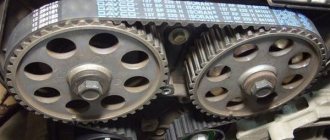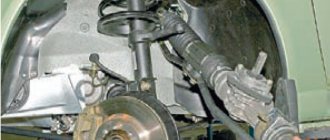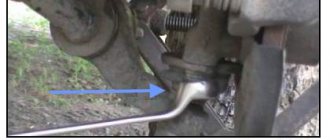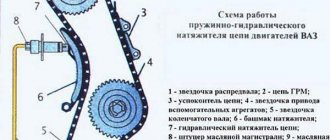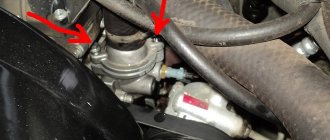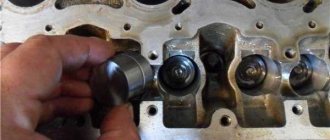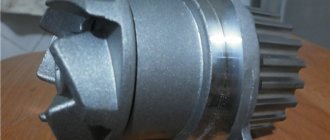The timing belt is one of the main engine parts and is included in the routine maintenance kit. This means that it must be replaced during the appropriate vehicle maintenance intervals. If this operation is not performed in a timely manner, the following engine malfunctions are possible:
- failure to start the internal combustion engine;
- malfunction of the gas distribution mechanism, requiring mandatory replacement of the timing belt, tensioning mechanism (roller, etc.), installation and adjustment of the ignition angle;
- in most cases, it may be necessary to repair the piston and valve group with all the work corresponding to the engine overhaul nomenclature.
It is the last point that brings fear to most car owners. Therefore, when purchasing a used car, every buyer should ask the seller when the timing belt was last replaced. You should not trust the information received 100%. First of all, he might be wrong. Secondly, the seller may not have reliable information. Therefore, after the purchase, it is better to carry out an extraordinary check of the condition of the elements of the gas distribution mechanism and decide on the timing of replacing the timing belt.
Purpose of the timing belt
The main purpose of the belt is to synchronize the rotation of the crankshaft and camshaft of the internal combustion engine. If the movement of these main drives of the crank mechanism and the valve system is not synchronous, two critical malfunctions occur:
- the engine combustion chambers will lack the necessary compression;
- The ignition angle is incorrect.
In most diesel engines and many gasoline engines, a situation may arise when “the valves meet the pistons.” When purchasing a car, you need to find out the exact name of the engine model that is installed on it. This can be done using the VIN, but sometimes the engine is changed during the operation of the car, then this is more difficult to do. According to the engine model, you need to enter a query into a search engine, for example, “4G63 engine valves meet pistons” or something like that. The received links must be analyzed. If the answer is clear: “they do occur,” the timing and mileage before replacement must be observed. If the belt breaks or jumps, it will most likely lead to capital failure.
Many car enthusiasts advise purchasing a car with an engine equipped with a chain timing mechanism. It is believed that they are more reliable. It is not always so. Even if it is a million-dollar engine, this does not mean that the chain guide should not be changed in a timely manner. This work can be more labor intensive than replacing a belt.
Causes of timing belt wear
The main reason why it is necessary to regularly replace the belt is natural wear. During vehicle operation, the belt moves at high speed along metal rollers, pulleys and guides, being under high tension.
At the same time, the belt is subjected to additional loads, which significantly increase wear:
- high temperature changes in the engine compartment (up to 100 degrees in winter);
- beating in case of wear of the tensioning mechanism;
- short-term loads due to internal combustion engine friction, uneven movement of valve pushers, changes in clearance values;
- liquids, contaminants and oils getting on the timing belt;
- random objects rubbing against the surface of the belt (casing, wires, fastening elements).
The cause of premature belt failure can be serious mechanical malfunctions of the engine:
- damage to the crank mechanism;
- jamming of valves and piston group;
- damage to the camshaft, rollers;
- wear of the crankshaft and camshaft guide pins.
If we take into account all the risks that arise during the operation of the belt, it is advisable to artificially reduce the resource declared by the manufacturer by 20 - 30%.
One of the reasons for premature wear: inadequate quality. Since the timing belt is an important component, you should not skimp on a dubious manufacturer and seller.
Signs of critical belt wear
Signs of wear are distinguished: direct and indirect.
Direct signs of wear include:
- presence of cracks on the belt surfaces (external and internal);
- chips on the inner surfaces of the teeth;
- longitudinal sections on the outer surface;
- presence of heavy contamination;
- visible runout and stretching of the timing belt;
- extreme cases - belt breakage, “licking” of teeth.
The listed signs can be detected by visual inspection. In most cases, this requires removing the belt cover. In some car models, this requires “hanging” the engine and carrying out a series of dismantling works. Therefore, before deciding to diagnose the condition of the belt drive, it is necessary to evaluate indirect signs of wear, which include:
- misfires in engine cylinders;
- detonation, especially at the moment of shutdown;
- uneven idle speed.
These signs can be examined using computer diagnostics. The most effective diagnostic result is achieved by studying the ignition angle in dynamic mode (with the engine running). Typically it should be within plus or minus five degrees. In this case, the ignition timing when the engine rotates at idle speed should not change significantly.
Timing for replacing timing belts
When the question is raised about the frequency of belt replacement, first of all, we mean the maximum period during which the belt retains its properties. At the same time, the probability of its stretching and breaking, which can lead to serious damage, is calculated.
There are special programs (AUTODATA, ELSA and others) that clearly establish the timing of routine maintenance, including the replacement of belts and rollers. However, these programs do not take into account the operating conditions of the car and available components. Ordinary drivers and most non-dealer service stations are guided by the established operating life and mileage of the car. It's better to judge by mileage. Many people estimate the period for mandatory belt replacement based on mileage to range from 50,000 to 80,000. However, if the car is used little, its annual mileage is, for example, 5,000 per year, this does not mean that the belt must be replaced every 10 years. The maximum service life of a car without replacing the timing belt is usually 5 - 7 years (subject to mileage conditions).
It is also necessary to take into account the characteristics of the engines. If the engine has two camshafts, there are more valves, and accordingly, greater loads are placed on the belt.
Replacing the timing belt Lada Kalina detailed instructions with photos
Replacing the timing belt of a Lada Kalina on a 16 valve engine is a rather labor-intensive operation. According to the manufacturer, the Lada Kalina timing belt needs to be checked every 15 thousand kilometers. On Kalina with 16 valves, a very reliable GATES belt is installed on the conveyor, which outlasts the tensioner and idler pulley and even the pump. Problems usually arise not because of the belt, but because of the rollers that are exhausting their service life. Therefore, it is better to check the Kalina timing drive once again than to engage in expensive engine repairs later.
Video
It’s rare that a car owner has not heard of the devastating consequences of a broken timing belt. The valves “fall” into the cylinders and break the pistons at top dead center. Sometimes, after this breakdown, the engine cannot be restored, or the repair involves such high costs that it is simply abandoned in favor of a contract engine. How often or after how many kilometers the timing belt needs to be changed, as well as how to evaluate its safe life, we will figure it out together with the specialists of the Auto-Master service.
Content:
Which Lada Kalina engines bend valves
At the moment, three types of power units are installed on the Lada Kalina. We are talking about the first generation of the car. The timing belt is replaced, according to the manufacturer’s recommendations, after 40 or 50 thousand kilometers. However, due to the design features of some engines, it is advisable to carry out this procedure a little earlier. So, let's look at the engines, their advantages and disadvantages.
1.6 liters, 8 valves
The motor has proven itself since the eight, as reliable and very durable. It is this Lada Kalina engine that does not bend the valve when the timing belt breaks.
Other Lada Kalina engines
Of course, it would be possible to consider each power unit separately in more detail, but this is not necessary, because it is the other two engines that bend the valves.
Factors affecting timing belt life
The frequency of replacing the timing belt and tensioner rollers is always indicated in the technical documentation of the vehicle. Every car owner should know this information and monitor the deadlines independently. But, as for any other node, this indicator is very conditional and depends on many factors. Let's sort them out.
Workmanship. Currently, timing belts are produced by several dozen companies. Manufacturers are trying to cover as large a market segment as possible. Therefore, for the same car you can find belts from several manufacturers, which will differ little visually. Unfortunately, before purchasing, you can only inspect it for accuracy of execution (smooth and well-stamped teeth without casting flaws, no protruding cord threads, equal width along the entire length of the belt).
Usually the following rule works: the more expensive the belt, the potentially higher quality, stronger and more durable it is.
Outlining through third-party equipment. How often the timing belt needs to be changed is largely influenced by this factor. If the timing belt simultaneously drives the pulleys of the pump, oil pump, distributor drive, and air conditioning compressor, its resource, despite the high quality of manufacturing, will be short.
The more pieces of equipment the timing belt drives, the greater the load placed on it.
Therefore, on cars where additional equipment has a separate drive, the timing belt resource is much longer. For example, on VAZ cars (up to Vesta and X-Ray models), the average belt life is 50–70 thousand. The reason is the large load created by additional equipment. At the same time, on many foreign cars, the timing drive, which operates only on camshafts, is capable of properly performing its functions for 120–150 thousand kilometers.
- The nature of the car's operation. A calm, measured ride has a beneficial effect on the life of the belt. Sharp rotation of the motor before cutoff will accelerate cord stretching and wear of the tooth surface.
- Security of the timing drive from the penetration of external and internal pollutants. Dust from outside and oil leaking through shaft seals can significantly reduce the life of the belt.
- Condition of gears. A good specialist will always inspect the teeth on the crankshaft and camshaft gears before replacing the timing drive. Because wear of the working surface and even single minor damage to the teeth can destroy the structure of the belt in a short period of time. By the way, on our website you can also learn how to choose a good car service center with a conscientious attitude to work based on several criteria.
Do not delay replacing the timing belt! Make an appointment with us right now by phone or using the form below. We are located at: Saransk, st. Stroitelnaya, 1, gate No. 5.
Replacing the timing drive on Lada Priora, Kalina and Granta cars (16 valves)
≡ November 6, 2015 Category: Repair
The replacement procedure differs slightly depending on the engine type.
Engine 21126 (1.6 l, 98 hp)
According to the operating rules for engine 21126 (Lada Priora and Lada Granta), the belt is changed every 180 thousand kilometers. And there were cases when the belt actually lasted that long. However, these cars come across a fair amount of defects. The belt fails mainly due to the self-tensioning roller, which falls apart. Therefore, we recommend changing the belt after 60 thousand mileage along with the tension and idler pulley.
After 30 thousand mileage, at each maintenance (after 15 thousand kilometers), the condition of the tension roller is checked for proper operation and the absence of “howling” sounds, as well as an external inspection of the belt.
Replacing the belt in advance is recommended because if the timing belt breaks, the valves are damaged. Only the original 126 belt should be installed (different from the others).
Engine 11194 (1.4 l, 89 hp)
On the Lada Kalina power unit, the timing drive is completely identical to the drive of the 21126 engine with all the ensuing advantages and disadvantages. If the belt breaks, the valves are damaged.
Engine 21124 (1.6 l, 89 hp)
On engine 21124, the belt is regularly changed every 60 thousand kilometers. On this engine, if the valve belt breaks, the valves are not damaged, so there is no need to change the belt ahead of time. It is recommended to carry a spare timing belt in the trunk. We tighten the roller the old fashioned way, with a special key (not self-tensioning). The roller must be changed every 90 thousand kilometers or when extraneous sounds appear.
Engine 2112 (1.5 l, 92 hp)
This engine was installed on VAZ 2110 series cars.
According to the technical data sheet, the belt must be replaced every 60 thousand km, however, if the belt breaks, damage to the engine valves occurs. Therefore, it is recommended to replace it after 30 thousand km. It is quite difficult to assess by appearance whether the belt will last 15 thousand kilometers or not - except in cases of obvious damage, when it is clear that the belt can break at any moment. Tension rollers should be changed if there is axial play or extraneous sounds, as well as after traveling 90 thousand kilometers.
Similarly, on 8-valve engines, if the timing belt breaks on engine 21116
the valves are damaged, but
not the 21114 engine
The difference between these engines is the lightweight piston on models with index 6 at the end (they are produced by Federal Mogul). Due to the use of lightweight piston engines, engines have become more powerful and more economical, but this comes at the cost of expensive repairs. AvtoVAZ engineers wanted to solve this by installing a Bosch timing belt with a service life of 200 thousand kilometers. It uses a modified tooth profile (requires different camshaft and crankshaft pulleys). But with this belt it is necessary to use an auto-tensioning roller (almost all foreign cars have one), which - unlike the German belt - is Chinese and often breaks down after 45-60 thousand kilometers.
The only difference in replacing the timing drive among all these engines is the installation of a self-tensioning roller. All other actions are identical. This will be indicated in the manual. The technology for checking the roller is described in detail in the article checking the timing belt tensioner on Lada Priora and Lada Kalina cars.
To replace, we will need - from the main tool:
- Head "17"
- Key "15"
- Key "13"
- Key "10"
- Key "8"
- Hex key "5"
- For 21126 and 11194 - a special wrench for tensioning the roller or pliers for removing the locking rings
- For 2112 and 21124 - a special key for tensioning the timing roller
From the additional tool:
- Wire brush
- A jack, a stand under the car and a balloon for lifting the car (according to the replacement technology, you need to remove the wheel and lift the car, but if you have some skill, you can replace it without lifting the car)
Remove the generator belt and drive pulley. The article describes in detail the replacement of the generator drive pulley on front-wheel drive VAZ and Lada cars.
1. Remove the plastic timing belt covers (upper and lower). The top one is screwed with 5 screws, the bottom one with 2 hexagon screws “5” (for clarity, the casing is removed in the photo):
2. Set the first cylinder to top dead center (TDC). To do this, we combine the marks on the camshaft pulleys with the slots on the casing:
3. Check that the mark on the crankshaft pulley matches the mark on the oil pump. The mark on the pulley is on the tooth next to the key (small dot). The mark on the pump is clearly visible from above (small slot):
4. Unscrew the tension roller “17”. The self-tensioning roller is secured with a 15mm bolt. On the left in the photo is tension, on the right is bypass:
5. Pull off the belt. It is more convenient to pry it off with a flat screwdriver. You can remove the belt along with the rollers.
6. Check the condition of the toothed rims of all pulleys. We change it if necessary.
7. It is advisable to unscrew the rollers and check the bearings for extraneous sound, jamming and axial play. If a discrepancy is found, we replace it with new ones and install them in place. Do not tighten the tension roller.
8. Check the condition of the pump for the absence of play and free rotation by rocking it by the pulley. It should turn without jamming.
9. Check that all marks match. We make sure that they did not move while removing the belt.
10. Put on a new belt. When installing, it is better to first put it on 1/3 of the width of the pulleys, check the marks and then push the belt in completely with your fingers.
11. Tension the belt with a roller. For engines with the old system we use a special key. The absence of a key can be replaced with drills and a screwdriver of suitable diameter (a key costs about 100 rubles.) You need to tighten it counterclockwise (same as on an 8-valve engine).
12. Check the tension by pressing your finger on the belt between the camshaft pulleys (shown by the arrow). With a force of 10 kg, the belt should bend about 5 mm.
13. The spring roller is tensioned slightly differently (for clarity, the photo shows the removed roller). We insert the pliers for removing the retaining rings into the grooves (shown by the lower arrows) and turn them counterclockwise until the groove aligns with the protrusion (shown by the upper arrows). Then tighten the roller with a 15mm bolt:
14. Check again to see if the marks on the pulleys have moved.
15. Screw the bolt into the crankshaft. It is better to install the generator wire pulley first. We turn the crankshaft at least two turns behind it. We make sure that there is no contact between the pistons and the valves.
16. Check the marks again. For a spring roller, it would be useful to check its performance using the method outlined in the article checking the timing belt tensioner on Lada Priora and Lada Kalina cars.
17. After checking, we assemble in the reverse order. We do not install only the upper plastic timing belt casing (which is secured with 5 hexagon screws “5”). This is necessary for a visual assessment of the work. After assembly, start the car and observe the belt. With a simple roller, the belt should not vibrate much when changing gaskets. With a spring roller, the verification procedure is indicated above. After 5 minutes of work, we turn off the car and check the tension. If everything is in order, then install the casing. If the tension is loose, then you need to tighten the tension roller and check the operation again.
Please rate the article
( 21 votes, average rating: 4.52 out of 5)
There were 3 comments left on the post “Replacing the timing drive on Lada Priora, Kalina and Granta (16 valves)” cars.
- Alexander:
06/15/2014 at 17:20
The only normal manual about replacing the timing belt)
Answer
- Shayakhmet Burkanuly:
11/16/2014 at 17:20
I have a Lada Kalina 11174, 16 valves. I can’t set the timing belt according to the mark, especially the lower crankshaft pulley. There is no label or data about it. Please help me and answer this question of mine.
Answer
- evga:
07/17/2016 at 16:19
Very sensible and understandable
Answer
Leave your comment
Click to cancel reply.
How often to change the timing belt
Drivers with a calm driving style and in the absence of factors that complicate the operation of the gas distribution mechanism drive can change the timing belt on a schedule. That is, if the operating instructions indicate that new rollers and a belt need to be installed after 60 thousand kilometers, we do so. When assessing the safe life of the timing drive, the automaker refers to average loads and additionally provides a small margin for periodic exposure to adverse factors.
However, there are a number of circumstances that have a great influence on how often the timing belt needs to be changed.
- Driving exclusively in city mode, especially with frequent stops in traffic jams. Here it would not be a mistake to change the timing belt 20–30% of the mileage earlier than the automaker recommends. In the vast majority of cases, passenger cars do not have an hour meter. And mileage is a very relative indicator. When driving on the highway, the engine can run 3–5 times less than during city use.
- Oiling the cavity under the timing drive. In this case, we change the belt along with the shaft seals immediately after detecting the problem. If the chain needs lubrication, then oil is detrimental to the belt. Despite the fact that most manufacturers today make belts from oil-resistant materials, the risk of sudden breakage due to oil ingress increases.
- Replacing any component that requires dismantling the timing drive. In this case, experienced motorists immediately change the belt, since its cost is usually low, and the cost of work sometimes exceeds the price of the roller and belt combined.
- Noticeable damage to the belt: cracks, delamination of rubber in the longitudinal and transverse plane, the appearance of cord threads, damage to the teeth. Noticed something like this? The timing belt needs to be changed immediately.
- Belt skipping on gears with valve timing offset. Regardless of the condition of the belt and its “age”, we replace it with a new one. Slippage on gear teeth is associated with large loads on the cord. And externally, a whole belt may have fatal damage to the reinforcing frame.
Timing belt tension on Kalina
This Lada has two types of engines. On a 16-valve internal combustion engine, an automatic timing belt tensioner is used, and on an engine with 8 valves, a tensioner roller is installed. In the case of a roller, the tension should be checked every 10-15 thousand kilometers and replaced after 75,000 kilometers.
On a 16-valve engine, you do not need to tighten it yourself; there is an automatic mechanism for this. The belt in such motors lasts longer. But, on the other hand, it is possible that the tensioner may fail or oil may get onto the teeth due to a faulty crankshaft oil seal. Breakage or wear of its teeth will lead to disruption of the gas distribution mechanism and subsequent repair of the internal combustion engine. Therefore, you should not rely only on the automatic mechanism and periodically check the wear status of the part during maintenance.
To carry out the procedure for tensioning the timing belt on a drive with a tensioner pulley, you will need a special wrench. The algorithm of actions is as follows.
- Using a 10mm wrench, unscrew the bolts securing the drive cover, lift it up and remove it.
- Rotate the timing drive mechanism by the camshaft pulley mounting nut, thereby assessing the degree of belt wear. There should be no oil stains, cracks, delaminations on the surface of the belt, and the teeth should not be worn out.
- At the middle level (between the camshaft and crankshaft pulleys), you should turn the belt 90 degrees to the right and left, without applying significant force. If the force is not enough to turn the belt 90 degrees, it means it is too tight and needs to be loosened. Accordingly, if the belt turns to a larger angle, it should be tightened.
To adjust the tension, you will need to cool the engine and use a 17mm spanner to loosen the tensioner roller fastener. Next, you will need a special key with which you need to turn the roller to the right or left (to tighten or loosen), after which, holding the key in the desired position, tighten the roller fastening nut. After this, the tension level is assessed again. If necessary, the procedure is repeated. If the belt is tensioned as required, you can put on the protective cover and secure it with three fastener bolts.
For a 16-valve engine equipped with an automatic tensioning mechanism, a similar procedure is not provided.
What is a timing belt
Of course, the vast majority of motorists are aware that there is a timing belt in the car, what it is needed for and what the abbreviation means. If you are not already aware of this issue, this omission needs to be corrected immediately, filling the gap in the knowledge base of any driver. Knowing what a timing belt is in a car and when to replace it is the responsibility of every vehicle owner.
The timing belt is a gas distribution mechanism, which is an internal combustion engine device, whose purpose is to control the supply of the air-fuel mixture, and the dosing procedure is performed at certain time intervals.
The belt, made of high-quality reinforced rubber, is part of the gas distribution structure. It has an important role in ensuring synchronous operation of the crankshaft and camshaft. Thus, the timing belt determines the movement of the mechanism components and is a direct participant in the procedure for supplying fuel and exiting combustion products.
The coordinated functioning of the mechanism parts also determines the optimal operation of the vehicle’s power unit. The condition of the device affects the serviceability of the entire mechanism, and its replacement is strictly regulated by the automaker; a description is included in the vehicle’s operating instructions.
If during the period of car warranty service you don’t have to worry about the quality of the timing belt, especially since the manufacturer supplies the original part, then in the future, when purchasing a replacement part, you need to be especially careful and not try to save money by purchasing a low-quality product, because the functioning of the engine depends on it.
There are symbols on the timing belt, let's look at examples of translation of the decoding:
Replacing the timing belt must be approached with all responsibility, since by ignoring the need for the procedure, you can bring a number of problems to your car and the quality of the purchase must be taken care of first of all. It is very important that the belt is original, so special attention should be paid to the manufacturer.
On some Japanese car models, the timing system is driven by a chain. If so, then there is no need to worry that the replacement date may be missed; the chain is replaced after 200,000-250,000 km. Well, the usual timing belt is most often replaced at each scheduled maintenance.
After how many thousand kilometers does it need to be changed?
It is impossible to accurately predict the life expectancy of a timing belt, especially if it has already been changed and a non-original mechanism part has been installed. Installing a non-original part is generally quite a risky endeavor, which can lead to unpleasant consequences for the mechanism and the engine as a whole.
When determining the frequency of replacement, you should also take into account the operating conditions of the vehicle. A number of factors affect the life of a timing belt. In addition to the fact that the part is constantly exposed to dynamic loads, temperature changes in the engine compartment, contact with random objects, ingress of liquids, dirt, etc., have an adverse effect. Damage and incorrect operation of other elements of the gas distribution mechanism can also accelerate wear.
When to change the timing belt can be found out from the technical documentation for the vehicle, since for a specific brand of car the frequency of replacement may differ due to design features, as well as the material of the product itself. On average, the timing belt needs to be changed after 50,000 kilometers of a car’s mileage, and no matter what mileage is indicated by the manufacturer, it must be taken into account that this refers to ideal operating conditions. So if the documentation states a figure of 120,000 km, then it can be safely reduced by 30-40,000 km.
For a new domestically produced car, the part usually needs to be replaced after 60,000 km, for an imported car after 70-80,000 km. If the timing belt on the car has already been changed, the timing is reduced to 50,000 and 60-70,000 km, respectively.
How to independently determine that it is time to change the belt
As mentioned above, a part can wear out much earlier than expected. You should be especially careful when buying a used car. A motorist can determine belt wear independently, but depending on the design, inspection may not be possible without the use of special tools. Taking into account the fact that a part always wears out to varying degrees, it is not worth neglecting to assess its condition, even if the time for the proposed replacement has not yet arrived.
A number of signs of wear that indicate replacement:
- cracks or other defects on the inside and outside of the product;
- longitudinal sections along the length of the part;
- worn teeth;
- severe contamination of the consumable;
- oil leakage, contact with the product;
- Belt breakage is a critical case.
The question of how to check the timing belt should be approached based on the characteristics of the mechanism. The above signs of wear can be noticed visually, but most often this requires dismantling the protective cover of the part. Some car brands require the engine to be suspended for this purpose. Diagnostics should be carried out unambiguously if signs hinting at wear are noticed, these are interruptions in the functioning of the car’s heart:
- detonation of the power unit;
- misfires in the cylinders;
- Rough idle.
Computer diagnostic research can accurately identify these signs. The most effective way is to check the ignition angle with the engine running (normal deviation is up to five degrees), but at idle it should not change significantly.
Replacing a timing belt requires certain skills and appropriate tools. Often during installation it is necessary to adjust the ignition timing. Many control systems block the motor from starting at an incorrect angle in order to prevent destruction of the mechanism.
When do you need to change timing belts and coolant pumps on AvtoVAZ models?
Many owners of domestic LADA models know that Granta, Kalina, Priora, Vesta and XRay are classified as “plug-in”, that is, when the timing belt breaks, the pistons meet the valves and then the engine faces expensive repairs.
To prevent this from happening, you need to change the pump, tension rollers and the belt itself in time.
What the manufacturer is silent about
The average car owner has information on servicing his VAZ model only from the factory instructions. For example, the booklet for the LADA Kalina indicates the service life of the belt, but there is no mention of its planned replacement. In the LADA Granta operating book, the manufacturer indicates the mileage of the timing belt for an 8-valve engine, while there is no information at all about the 16-valve version.
In some LADA Priora service books, the timing belt is not mentioned at all.
Vesta and XRay car owners are “lucky” - the service book indicates the timing for adjusting the timing belt gaps.
The planned replacement of the timing belt and rollers is indicated only in the instructions for the 8-valve engine of the Vesta and VAZ-11189 models, while it is recommended to replace the same belt twice, while there is not a word about the pump at all.
Water pump
Neglecting to replace and maintain the water pump can render the power unit inoperative. Let us remember that the pump belongs to the cooling system, but is driven by a timing belt. When the pump jams, due to bearing wear, the teeth in the belt are cut off and the motor is destroyed. All these details are familiar to the craftsmen, while the manufacturer did not even think to mention the need to monitor the condition of the water pump.
When to change the belt and pump
It should be noted that the new AvtoVAZ engines have high-quality timing belts, and if oil does not get on them, then they will run for the indicated 180 thousand kilometers.
Along with this, owners of any foreign car with significant mileage know that a planned belt replacement entails a comprehensive replacement, which includes a belt, a roller and a pump - this is both cheaper and more correct.

